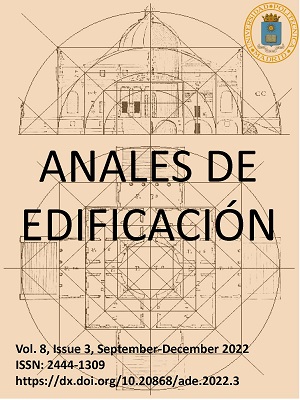Diseño tecnológico de un lugar de culto: valor histórico y constructivo = Technological design of a worship place: historical and constructive value
DOI:
https://doi.org/10.20868/ade.2022.5099Palabras clave:
Diseño tecnológico, Genius Loci, Valor simbólico, Lugar de culto cristiano, Rendimiento tecnológico, Technological design, Symbolic value, Christian worship site, technological performanceResumen
La revolución del diseño tecnológico no sólo se deriva del uso de nuevas tecnologías, sino de un diálogo entre el valor arquitectónico, histórico y funcional que conservan los lugares y su valor simbólico. Se trata de un proceso complejo y lleno de matices que tiene en cuenta no sólo las características físicas de un edificio, sino también su significado cultural e histórico. Al analizar las características arquitectónicas e históricas de un edificio, los diseñadores son capaces de identificar la calidad formal y material de la arquitectura, así como el poder creativo vinculado al genius loci, o espíritu del lugar. La afirmación de Servius, "Nullus locus sine genius", subraya la importancia de comprender el carácter único de un lugar, ya que influye en el diseño y la función del espacio. Esto es especialmente cierto en el caso de los lugares de culto cristianos, donde cada piedra, distribución espacial y ornamento conlleva un profundo significado simbólico, moral y social. El diseño de una iglesia no es una mera cuestión estética o funcional, sino una empresa teológica y espiritual que requiere un planteamiento consciente de la tecnología y el diseño. El proyecto tecnológico de una iglesia antigua requiere una interpretación material y simbólica de las transformaciones históricas que ha sufrido el edificio. Esto incluye un examen cuidadoso del contexto físico y cultural del edificio, así como una comprensión del significado teológico y espiritual de sus elementos de diseño.
Abstract
The revolution of technological design is not only derived from the use of new technologies, but from a dialogue between the architectural, historical, and functional value that places preserve, and their symbolic value. It is a complex and nuanced process that considers not just the physical characteristics of a building, but also its cultural and historical significance.In analyzing the architectural and historical features of a building, designers are able to identify the formal and material quality of architecture, as well as the creative power linked to the genius loci, or the spirit of the place. The statement by Servius, "Nullus locus sine genius," emphasizes the importance of understanding the unique character of a location, as it influences the design and function of the space. This is especially true for Christian places of worship, where every stone, spatial distribution, and ornament carries a deep symbolic, moral, and social meaning. The design of a church is not merely a matter of aesthetics or function, but a theological and spiritual undertaking that requires a conscious approach to technology and design. The technological project of an ancient church requires a material and symbolic interpretation of the historical transformations that the building has undergone. This includes a careful examination of the building's physical and cultural context, as well as an understanding of the theological and spiritual significance of its design elements.
Descargas
Referencias
Dianich S. La Chiesa e le sue chiese. Teologia e architettura. San Paolo Edizioni. Milano; 2008
Eugeni R. La semiotica contemporanea. una breve introduzione. Aggiornamento 2011-2012. Università Cattolica Sacro Cuore. Cfr. https://ruggeroeugeni.files.wordpress.com/2009/04/la-semiotica-contemporanea-2011-2012.pdf (accessed on 30/03/2019)
Farabegoli J., Valentini N. (ed by). Architettura, Arte e Teologia. Il simbolismo della luce nello spazio liturgico. Pazzini Editore, Villa Verucchio 2013
Frisetti A., Cuomo M., Abate N., Di CosmoL. La chiesa di S. Leo a Sessa Aurunca (CE): scavo, tecniche di analisi, reperti ed apparati decorativi, in “IV Ciclo di Studi Medievali”, Atti del Convegno, Firenze 4-5 Giugno 2018, Arcore (MB) 2018, pp. 327-338
Hani J. Il simbolismo del tempio cristiano (trad. dal francese di Buonacerva T.). Edizioni Arkeios, Roma; 1996 p. 57; p. 124
Norberg-Schulz, Christian. Genius loci: paesaggio, ambiente, architettura. Italia, Electa, 1992.
Descargas
Publicado
Número
Sección
Licencia
1. Los autores conservan los derechos de autor y garantizan a la revista el derecho de una Licencia Creative Commons Atribución - Nocomercial 4.0 Internacional que permite a otros compartir el trabajo con un reconocimiento de la autoría y uso no comercial.
2. Los autores pueden establecer por separado acuerdos adicionales para la distribución no exclusiva de la versión de la obra publicada en la revista (por ejemplo, situarlo en un repositorio institucional o publicarlo en un libro).
Salvo indicación contraria, todos los contenidos de la edición electrónica se distribuyen bajo una licencia de uso y distribución “Creative Commons"












